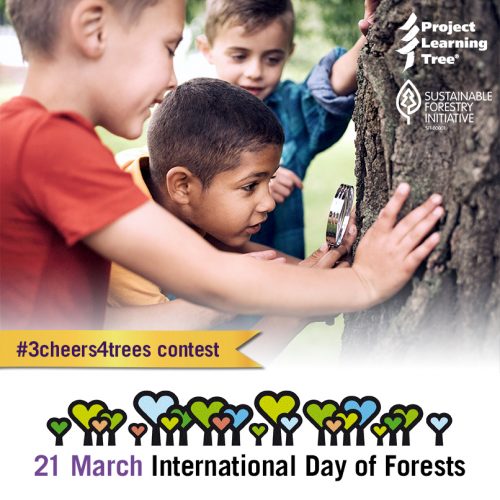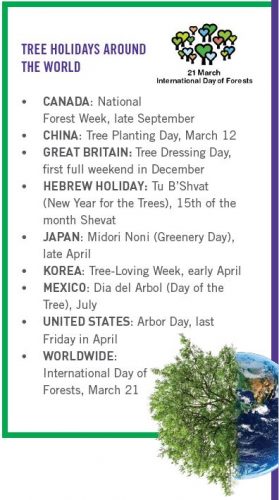March 6, 2019
 Trees and forests provide many benefits to people and communities all over the world. Trees beautify our environment; provide homes and food for wildlife; capture air pollutants; store carbon; prevent soil erosion; reduce runoff; shade and cool streets and buildings; muffle traffic noise; and provide places for children to climb and play.
Trees and forests provide many benefits to people and communities all over the world. Trees beautify our environment; provide homes and food for wildlife; capture air pollutants; store carbon; prevent soil erosion; reduce runoff; shade and cool streets and buildings; muffle traffic noise; and provide places for children to climb and play.
It’s also surprising to learn how many different products we get from trees.
- Wood products – lumber, baseball bats, toothpicks, wood blocks, wood furniture, etc.
- Food products – apples, cinnamon, chocolate, maple syrup, oranges, walnuts, etc.
- Paper products – books, newspaper, paper towels, toilet paper, etc.
- Sap products – soap, rubber, crayons, adhesives, shoe polish, cosmetics, etc.
- Other products – rayon, cork, medicines, etc.
Forests and Education
The theme for 2019 International Day of Forests on March 21 is Forests and Education—Learn to Love Forests! To celebrate we’ve compiled 8 ideas for things to do with youth to explore and celebrate the gifts we receive from trees.
These ideas come from the classic Project Learning Tree activity Three Cheers for Trees. If you’d like to check out the full activity, age-specific versions can be found in PLT’s PreK-8 Environmental Education Activity Guide and PLT’s Environmental Experiences for Early Childhood guide.
8 Ideas from Three Cheers for Trees
Try one of these ideas to help children learn about forests and share your photos on social media.
- Discuss the products we get from trees. Show children a variety of objects we get from trees and ask them to name other services and products that trees provide.
 Learn how the world and its many cultures and people celebrate trees and forests– and plan your own tree celebration. (see “Tree Holidays around the World”).
Learn how the world and its many cultures and people celebrate trees and forests– and plan your own tree celebration. (see “Tree Holidays around the World”).- Decorate a tree with small tree products (e.g., fruits, nuts, and pencils), drawings or photo cutouts of things we get from trees.
- Enjoy a snack from trees, using tree fruit dipped in a tree topping (such as almond butter, coconut, or a cocoa and powdered sugar mixture). Safety: Be aware of any food allergies, dietary needs, or choking hazards.
- Write a group book titled “Trees are Terrific.” Each author might contribute a story or drawing on a favorite tree product, or tree benefit, or that describes their feelings about trees.
- Adopt the street trees in your neighborhood. Street trees are part of the “urban forest.” During dry periods, you can help them by watering them thoroughly once a week.
- Plant a tree seed or seedling. Use PLT’s family activity What Tree Should I Plant? or check with a local forester or nursery for an appropriate tree species that is native to your area.
- Research forests around the world (such as the Redwood Forest in California, the Cloud Forest in Costa Rica, the Black Forest in Germany) and compare them to the forest in your area.
You can also download these ideas as a one-page PDF:
- In English: Three Cheers for Trees
- In Spanish: ¡Vivan los árboles!
- In French: Bravo, les Arbres!
#3cheers4trees Contest
Share what your students / youth do to learn about forests:
- Conduct one or more activities from our list of suggestions above.
- Take a photo of your students working to complete the activity, or a photo of their results.
- Post it on social media with the hashtags #3cheers4trees and #IntlForestDay for the chance to win a prize!
Note: Please ensure all posts meet your school/district/organization’s privacy policy.
Entries will be accepted through March 31, 2019 on Facebook and Twitter.
A panel of judges will select 3 winners. Each winner can choose to receive either:
- a free PLT curriculum of your choice from Shop.PLT.org, or
- a free item of clothing from the Sustainable Forestry Initiative / Project Learning Tree.
For more information, view the official PLT #3cheers4trees Contest Rules.


